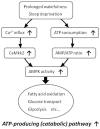The role of ATP in sleep regulation
- PMID: 22207863
- PMCID: PMC3246291
- DOI: 10.3389/fneur.2011.00087
The role of ATP in sleep regulation
Abstract
One of the functions of sleep is to maintain energy balance in the brain. There are a variety of hypotheses related to how metabolic pathways interact with sleep/wake regulation. A major finding that demonstrates an interaction between sleep and metabolic homeostasis is the involvement of adenosine in sleep homeostasis. An accumulation of adenosine is supplied from ATP, which can act as an energy currency in the cell. Extracellularly, ATP can act as an activity-dependent signaling molecule, especially in regard to communication between neurons and glia, including astrocytes. Furthermore, the intracellular AMP/ATP ratio controls the activity of AMP-activated protein kinase, which is a potent energy regulator and is recently reported to play a role in the regulation of sleep homeostasis. Brain ATP may support multiple functions in the regulation of the sleep/wake cycle and sleep homeostasis.
Keywords: AMPK; ATP; adenosine; astrocyte; sleep.
Figures



Similar articles
-
The role of ATP in sleep-wake regulation: In adenosine-dependent and -independent manner.Sleep Med. 2024 Jul;119:147-154. doi: 10.1016/j.sleep.2024.04.031. Epub 2024 Apr 24. Sleep Med. 2024. PMID: 38678758 Review.
-
Adenosine-independent regulation of the sleep-wake cycle by astrocyte activity.Cell Discov. 2023 Feb 7;9(1):16. doi: 10.1038/s41421-022-00498-9. Cell Discov. 2023. PMID: 36746933 Free PMC article.
-
Pannexins Are Potential New Players in the Regulation of Cerebral Homeostasis during Sleep-Wake Cycle.Front Cell Neurosci. 2017 Jul 17;11:210. doi: 10.3389/fncel.2017.00210. eCollection 2017. Front Cell Neurosci. 2017. PMID: 28769767 Free PMC article.
-
Allosteric regulation of AMP-activated protein kinase by adenylate nucleotides and small-molecule drugs.Biochem Soc Trans. 2019 Apr 30;47(2):733-741. doi: 10.1042/BST20180625. Epub 2019 Apr 18. Biochem Soc Trans. 2019. PMID: 31000529 Review.
-
Regulation of neuron-astrocyte metabolic coupling across the sleep-wake cycle.Neuroscience. 2016 May 26;323:135-56. doi: 10.1016/j.neuroscience.2015.12.007. Epub 2015 Dec 17. Neuroscience. 2016. PMID: 26704637 Review.
Cited by
-
Adenosine deaminase polymorphism affects sleep EEG spectral power in a large epidemiological sample.PLoS One. 2012;7(8):e44154. doi: 10.1371/journal.pone.0044154. Epub 2012 Aug 29. PLoS One. 2012. PMID: 22952909 Free PMC article.
-
Sleep deprivation impairs memory by attenuating mTORC1-dependent protein synthesis.Sci Signal. 2016 Apr 26;9(425):ra41. doi: 10.1126/scisignal.aad4949. Sci Signal. 2016. PMID: 27117251 Free PMC article.
-
Circadian Clocks, Sleep, and Metabolism.Adv Exp Med Biol. 2021;1344:21-42. doi: 10.1007/978-3-030-81147-1_2. Adv Exp Med Biol. 2021. PMID: 34773224
-
Sleep Promotion by 3-Hydroxy-4-Iminobutyric Acid in Walnut Diaphragma juglandis Fructus.Research (Wash D C). 2023 Sep 19;6:0216. doi: 10.34133/research.0216. eCollection 2023. Research (Wash D C). 2023. PMID: 37732131 Free PMC article.
-
Diffuse brain injury induces acute post-traumatic sleep.PLoS One. 2014 Jan 8;9(1):e82507. doi: 10.1371/journal.pone.0082507. eCollection 2014. PLoS One. 2014. PMID: 24416145 Free PMC article.
References
LinkOut - more resources
Full Text Sources

